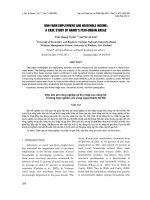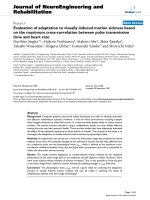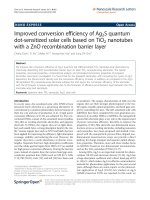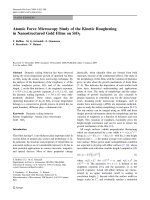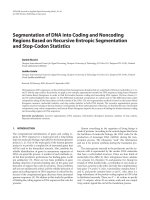Practical study of purification of Lao Cai wet process phosphoric acid, based on tributyl phosphate (TBP) – kerosene mixture solvent extraction
Bạn đang xem bản rút gọn của tài liệu. Xem và tải ngay bản đầy đủ của tài liệu tại đây (277.48 KB, 5 trang )
Journal of Science & Technology 134 (2019) 006-010
Practical Study of Purification of Lao Cai Wet Process Phosphoric Acid,
Based on Tributyl Phosphate (TBP) – Kerosene Mixture Solvent Extraction
Bui Quang Tuan, Nguyen Dang Binh Thanh, Nguyen Trung Dung, Ta Hong Duc *
Hanoi University of Science and Technology, No. 1, Dai Co Viet, Hai Ba Trung, Hanoi, Viet Nam
Received: January 17, 2018; Accepted: June 20, 2019
Abstract
The purification of wet process phosphoric acid using solvent extraction has been widely applied at industrial
scale. However, the performance of the purification depends strongly on the solvent characteristics. Common
solvents used for the extraction are butanol, hexanol, tributyl phosphate (TBP) and MIBK mixture, … in which
TBP/Kerosene have proved to be one of the the most efficient solvent mixture. In this work, the effects of
temperature, solvation heat, mixing time, and organic/aqueous phase ratio on the extraction of Lao Cai wet
process phosphoric acid was studied. The obtained results from experiments that have true potential to apply
in the industrial manufacturing process.
Keywords: liquid-liquid extraction, wet phosphoric acid, Tributyl phosphate, TBP, Kerosene
crude WPA for food or technical grade acids such as
solvent extraction, paramagnetism, electrodialysis,
electrodeposition and electrode ionization on ion
exchange textiles [4]. However, solvent extraction has
been widely employed in the commercial processing
line of the food and technical grade phosphoric acid all
over the world. Moreover, the advantages of this
technique have been proved on recovery any of
valuable elements from the raffinate as an added value
to the solvent extraction process. This method is not
only easy in operation, but also cost effective. In this
study, the solvent extraction method was selected for
the purification of WPA. The process consists of three
major steps: (1) the solvent was added to separate
phosphoric acid from the feeding acid by liquid-liquid
extraction, (2) purified acid was recovered by water,
and (3) the solvent was also reverted for the circulation
in the purification process.
1. Introduction
*
Phosphoric acid has widely used in chemical
industry, especially in the food industry. The demand
of highly pure phosphoric acid has been increasing
remarkably in recent years. In general, phosphoric acid
is manufactured by two major processes: wet process
and thermal process. The raw material for the thermal
process is phosphorus, which is produced from apatite
ore in the arc furnace. Phosphorus is then oxidized and
hydrated to obtain phosphoric acid [1, 2]. The acid
produced by the thermal process has a much higher
purity, essentially containing only the phosphatic
value. However, this process consumed too much
energy that made its cost increased significantly in the
last ten years. In practical industry, the cost of raw
material, yellow phosphorus, accounting for 95,5%
total production cost. Moreover, the price of coke and
electricity has risen, and the basic investment capital
for thermal process phosphoric acid has climbed
simultaneously. So this process has been gradually
limited and tended to decrease because of its large
energy consumption and environmental impact
problems.
Laila A. Guirguis et al. studied the purification
process of crude phosphoric acid by TBP/Butanol
mixture in a single stage extraction process. In their
work, separation efficiency has achieved of 43% [4].
The work of Moussa Alibrahim [5] showed that
Kerosene gives the highest extraction yield with TBP
in WPA purification compared to the other diluents
such as benzene, toluenne and chloroform. In another
study, Laila A. Guirguis et al. [6] also purified H3PO4
by a mixture of hydrophobic and hydrophilic solvent
extraction in a single stage extraction from crude
phosphoric acid containing 57,75% P2O5. The
hydrophilic and hydrophobic solvents they were used
Wet process phosphoric acid (WPA) is produced
based on a reaction between phosphate ore and a
mineral acid, usually sulfuric acid. Phosphoric acid
obtained from the wet process contains inorganic and
organic contaminants present in the raw materials with
a variable concentration depending on the crude
phosphate origin and its pretreatment [3]. Several
techniques are employed to refine the acid from the
*
Corresponding author: Tel.: (+84) 916938659
Email:
6
Journal of Science & Technology 134 (2019) 006-010
in their research namely methanol and hexanol. The
phosphate containing components were distributed in
high molecules weight alcohol fraction while the
impurities were segregated to low molecules weight
alcohol fraction. The optimum ratio for the extraction
mentioned in the work was five parts of methanol, one
part of fed acid and four parts of hexanol. Using the
proposed ratio, the recovery of 95% was achieved
however, methanol/hexanol solvent mixture were
rarely used in industrial scale. Mohamedalkhaled
Abdulbake et al. [7] studied the synergistic effect of
some alcohols on the extraction of H3PO4 from Syrian
WPA by Tributyl Phosphate (TBP). The results
showed that the stirring time does not cause a
significant effect on extraction which indicates that
extraction is not diffusion controlled. Besides, it also
showed the negative effect of temperature on the
extraction of H3PO4 but in the stripping, temperature
has positive effect. The separation time for the
extraction by TBP with alcohols as diluent is smaller
than that by TBP with kerosene at the phase ratio O/A
= 5/1. Furthermore, Hannachi Ahmed et al. [8] had a
study on the purification of WPA by solvent extraction
with a mixture of TBP and MIBK (methyl isobutyl
ketone). They stated that the order of selectivity for the
extraction is MIBK < solvent mixture of TBP and
MIBK < TBP.
200-1100 nm is used for spectrophotometric
determination of sulfate, phosphate and total rare
earth elements.
2.3. Analysis Procedures:
2.3.1. Analytical procedures:
Many chemicals and instrumental analysis
methods were used for the quantitative determination
of major, minor and trace elements of the present
phosphoric acid, according to ISO 6353-2:1983 Reagents for chemical analysis - Part 2: Specifications.
2.3.2. Extraction analysis:
Extraction was carried out in a beaker with a
paddles blades stirrer placed in a thermostat to control
the temperature. Given amounts of each of the aqueous
and organic phases were mixed during a determined
time period and then liquid-liquid phase separation
process was carried out in a separating funnel.
The concentration of P2O5 in the aqueous phase
was determined by the citroammonium molybdate
method, whereas the concentration of P2O5 in the
solvent was calculated from the material balance.
The distribution ratio (D) was calculated from
equation (1):
D = [P2O5]organic / [P2O5]aqueous
In the present study, the solvent extraction of Lao
Cai WPA is addressed and the effects of temperature,
mixing time, solvation heat and the Organic/Aqueous
phase ratio on the process efficiency are also analyzed.
where: [P2O5] = weight percent of P2O5.
The extracted P2O5 content (%E) was calculated from
the equation (2):
2. Experiments
%E = 100 D (P) / [1 + (P) D]
2.1. Materials
-
The main and starting material for the present
work is a commercial WPA containing 48,9%
P2O5 which is supplied by Duc Giang – Lao Cai
chemicals joint stock company, Tang Loong
Industrial zone, Tang Loong, Bao Thang, Lao Cai.
-
TBP: 98%; density 0,978 ± 0,02; color ≤ 0,5.
-
Kerosene (carbon chain: 6 – 16 C); density: 0,775
– 0,840 g/ml; viscosity at 20oC: < 8cSt;
autoignition temperature: 220oC; T100 < 300oC;
freezing point: < -50oC.
-
(2)
Where: P (phase ratio) is value of organic / value of
aqueous (or O/A)
D: the distribution ratio
The degree of phase separation with respect to
time was determined by measuring the change of
height level from the phase interface to the bottom of
the column.
3. Results & Discussion
3.1. Chemical analysis:
The reagents used in the experiments were of
analytical grade quality and double-distilled
water was used in all preparations.
The analyzed composition of raw WPA produced
at Lao Cai chemicals joint-stock company is shown in
Table 1:
2.2. Instrumentations
-
(1)
A Shimadzu 160 A Double beam UV
spectrophotometer with a wavelength range of
7
Journal of Science & Technology 134 (2019) 006-010
Table 1. Chemical analysis of industrial grade phosphoric acid.
No.
1
2
3
4
5
6
7
8
9
10
11
12
13
14
15
16
17
18
19
Property
Total P2O5
Unit
%(m/m)
Result
48,9
Method
ISO 3706:1976
(Quinoline Phosphomolybdate Gravimetric method)
ISO 3706:1976 ICP
ISO 3706:1976 ICP (MOD)
ISO 6353/2:1983 ICP
ISO 3706:1976 ICP (MOD)
FCC 8-Fluoride Limit Test-ISE III
IS 798-1986
Ref. ISO 11923:1997
CaO
MgO
Fe2O3
Al2O3
Fluoride (F)
Sulfate (SO42-)
Total suspended solid
content
Arsenic (As)
Chloride (Cl)
Density at 30oC
Chromium (Cr)
Cadmium (Cd)
Titanium (Ti)
Nikel (Ni)
Molybdenum (Mo)
Vanadium (V)
Lead (Pb)
Mercury (Hg)
%(m/m)
%(m/m)
%(m/m)
%(m/m)
%(m/m)
%(m/m)
%(m/m)
0,04
0,59
1,98
3,19
0,54
3,67
1,87
ppm
ppm
Kg/L
ppm
ppm
ppm
ppm
ppm
ppm
ppm
ppm
15,1
<20
1,702
42,9
<1
136
24,8
1,66
31,6
7,5
Not detected
(LOD
0,01ppm)
AOAC 2012 (2013/06)/ICP
ISO 6227:1982
ASTM D-4052-15
ISO 6353/2-1983/TCP (MOD)
ISO 6353/2-1983/TCP (MOD)
ISO 6353/2-1983/TCP (MOD)
ISO 6353/2-1983/TCP
ISO 6353/2-1983/TCP (MOD)
ISO 6353/2-1983/TCP (MOD)
ISO 6353/2-1983/TCP
US EPA 7470A:1994
(NIC Mercury Analyzer-WA-5A)
Remark: - The analyses have been performed in accordance with latest issues of the relevant test methods unless
otherwise stated;
- Precision parameters apply to the determination of above test results. Also refer to ASTM 3244, IP
367 and Appendix E of IP Standard Method of analysis and testing for utilization of test data to determine
conformance with specifications;
- %(m/m) = %(w/w) = wt% = %mass; mg/kg = ppm(m/m) = ppm mass = ppm(w/w) = ppm wt;
- LOD: Limit of detection.
By integration, K is calculated by:
3.2. Effect of temperature on the extraction process
Effect of temperature on the extraction process
was studied. Four experiments at different
temperatures
were
performed
with
O/A
(organic/aqueous) ratio of 5/1. The organic solvent
used was TBP/Kerosene mixture at ratio
TBP/Kerosene of 6/4. The mixing time and settling
time was set to 3 and 5 minutes, respectively. Stirring
speed of 400 rpm was used at the mixing stage. The
results obtained from the experiments showed that as
the temperature increased the extraction efficiency
(%E) was decreased. In this work, the effective
temperature for the extraction process was 32oC as
illustrated in Fig. 1.
lnK = (-ΔH / R) (1 / T) + a
46
E, %
45
44
43
42
The relation between the equilibrium constant K and
the temperature is given by Van Hoff’s equation [1]:
30
d lnK / dT = ΔH / R.T2
40
50
60
Temperature (oC)
70
Fig. 1. Effect of temperature on the extraction
efficiency (%E).
where R is gas constant (R = 8,314 J/mol-K)
8
Journal of Science & Technology 134 (2019) 006-010
Since the distribution ratio D is related by
definition to the equilibrium constant K the previous
equation could be written as follows:
According to the experimental results, it is
possible to noticed that the solvation heat has a small
effect on extraction.
lnD = (-ΔH / R) (1 / T) + a
3.4. Effect of stirring time on the extraction process
The experimental results are plotted in Fig. 2 where
lnD is considered as a function of 1000/T(oK). Using
linear regression, it is possible to calculate ΔH = -2013
J/mol.
Effect of the mixing time on the extraction
process was examined at O/A (organic/aqueous) phase
ratio of 5/1 using TBP/Kerosene mixture with ratio of
6/4. The settling time was set to 5 minutes and the
stirring speed was set to 370 rpm. Initial temperature
of Solvent and crude acid was 32oC. Experimental data
of extracted P2O5 content (%E) as a function of mixing
time are shown in Fig. 4. It can be stated from the
measurement that the effective stirring time is 60
seconds.
-1,560
-1,580
lnD
-1,600
50,00
-1,620
y = 0,2343x - 2,3418
R² = 0,9935
-1,660
2,90
3,00
3,10
1000/T
3,20
40,00
E, %
-1,640
3,30
30,00
20,00
Fig. 2. Effect of temperature on the distribution ratio.
10,00
3.3. Effect of solvation heat on the process mixture
temperature
0,00
0
Effect of solvation heat on the phase mixing
process was conducted at O/A (organic/ aqueous) ratio
of 5/1 by the solvent mixture TBP/Kerosene with the
ratio of 6/5. The stirring speed was set to 370 rpm.
Solvent and crude acid were initially input at room
temperature (32oC) and the mixing temperature
variation is monitored continuously throughout the
experiment. The total time of phase mixing was 180
seconds. The mixing temperature profile obtained
from the measurement was depicted in Fig. 3.
50
100
Time (s)
150
200
Fig. 4. Effect of stirring time on the extraction
efficiency (%E).
50
40
E (%)
30
50
20
10
Temperature (oC)
40
0
1/1
30
20
2/1
3/1
4/1
O/A ratio
5/1
6/1
Fig. 5. Effect of organic/aqueous phase ratio on the
extraction efficiency (%E).
10
3.5. Effect of organic/aqueous phase ratio (O/A) on
the extraction process
0
0
30
60
90
120
150
180
210
Six different organics to aqueous phase ratios
namely 1/1, 2/1, 3/1, 4/1, 5/1 and 6/1 were used to
figure out the proper phase ratio for extraction of P2O5
from the feeding WPA. The remaining operation
parameters are kept as mentioned before. The
measured data of the extraction efficiency (%E) with
respect to O/A ratio are given Fig. 5. Regarding to the
Time (s)
Fig. 3. Effect of phase contact time on the mixture
temperature
9
Journal of Science & Technology 134 (2019) 006-010
combined effects of other operating parameters, as the
O/A ratio increased, effect of the process rose. But the
rise step of effect increased become smaller.
Additionally, when O/A ratio using is big enough, the
productivity of the purification process therefore so
small. Thus, due to the change of effect on extraction
process is insignificant, the appropriate organic to
aqueous phase ratio could be taken as 5/1.
[2]
Shute et al., Heat recovery in manufacture of
phosphorus acid, US patent No. 4713228, 1987.
[3]
Shlewit H, Khorfan S, Purification of phosphoric acid
by solvent extraction with TBP/kerosene, Solvent
extraction research and development 9, (2002) pg 5968.
[4]
Laila A. Guirguis, Nagwa. I. Falila, Lele H. Khalil,
One Stage Solvent Extraction Synergism for the
Purification of Industrial Wet Process Phosphoric Acid
to the Food Grade Quality, International Journal of
Advanced Research (2016), Volume 4, Issue 4, 15541564.
[5]
Moussa Alibrahim, Extraction of phosphoric acid from
various aqueous solutions using tributyl phosphate
(TBP), Chemical Engineering 51/1 (2007) pg 39–42.
[6]
Laila A. Guirguis, Hisham K. Fouad and Fatma A.
Salem, Purification of phosphoric acid by mixture of
hydrophilic and hydrophobic extractants, Sohn
Internal, Syrpoin, Advanced processing of metals and
materials, Vol. 3 (2006).
[7]
Mohamedalkhaled
Abdulbake,
Omar
Shino,
Synergistic effect of alcohols on the extraction of
H3PO4 from Syrian wet phosphoric acid by TBP,
Chemical Engineering 51/1 (2007), pg 3-6.
[8]
Hannachi Ahmed, Habaili Diamonta, Chtara Chaker,
Ratel Abdelhamid, Purification of wet process
phosphoric acid by solvent extraction with TBP and
MIBK mixtures, Separation and Purification
Technology 55 (2007) pg 212–216.
4. Conclusions
At low temperature (below 60oC), the extraction
is slightly influenced by temperature, however, when
the temperature goes higher, extraction percent is
decreased. Therefore, one can prove that the
temperature has a small negative effect on the
extraction process and room temperature could be an
appropriate operating parameter of the extraction.
The solvation heat has a small effect on
extraction, which indicates that extraction is
considered to be mixing controlled rather than
diffusion controlled.
The effective time interval for the mixing step is
60 seconds and the cost-effective organic to aqueous
phase ratio is 5/1.
References
[1]
Kuxdorf et al., Process for making phosphorus
pentoxide and optionally phosphoric acid with
utilization of the reaction heat, US patent No. 4603039,
1986;
10
